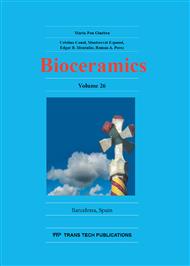p.253
p.258
p.262
p.269
p.275
p.283
p.289
p.295
p.300
Effect of Variation of Dispersant and Fluid in the Rapid Prototyping of Alumina
Abstract:
The use of rapid prototyping technologies in the manufacturing ceramic materials has been developed in recent years due to its many advantages. Studies combining rapid prototyping using biomaterials as raw material increased significantly in recent years. The inkjet printing involves using ceramic powder with binder and a fluid released onto the sample through a printhead. The effect of dispersant in conventional manufacturing of alumina-based materials was widely known. However, there are few studies dealing on this issue for rapid prototyping. This work aims to obtain pieces of alumina via a 3D printer, inkjet model, varying concentrations of dispersant and fluid in order to compare its influence. The specimens were evaluated for their apparent porosity, density and dimensions. It was concluded that 1.0% of dispersant combined with a larger amount of solvent resulted in parts with suitable dimensions and higher mechanical strength.
Info:
Periodical:
Pages:
275-279
Citation:
Online since:
November 2014
Keywords:
Price:
Сopyright:
© 2015 Trans Tech Publications Ltd. All Rights Reserved
Share:
Citation:


